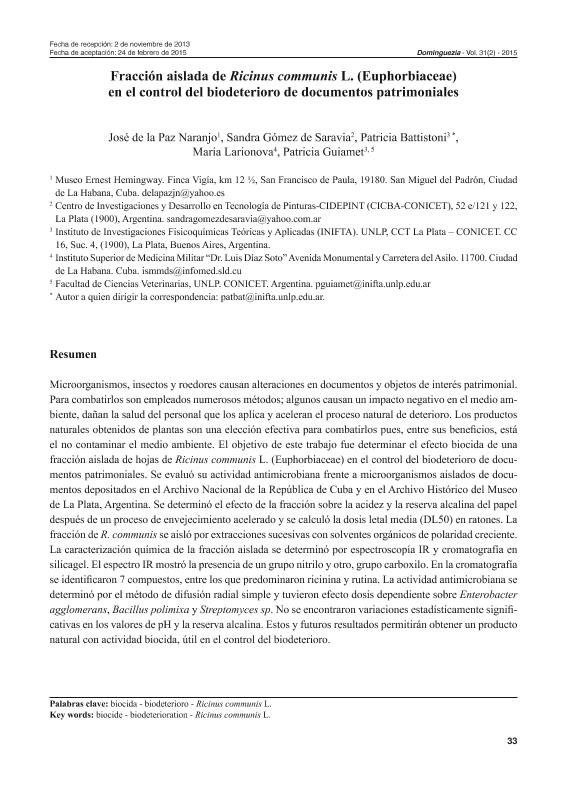Artículo
Microorganismos, insectos y roedores causan alteraciones en documentos y objetos de interés patrimonial. Para combatirlos son empleados numerosos métodos; algunos causan un impacto negativo en el medio ambiente, dañan la salud del personal que los aplica y aceleran el proceso natural de deterioro. Los productos naturales obtenidos de plantas son una elección efectiva para combatirlos pues, entre sus beneficios, está el no contaminar el medio ambiente. El objetivo de este trabajo fue determinar el efecto biocida de una fracción aislada de hojas de Ricinus communis L. (Euphorbiaceae) en el control del biodeterioro de documentos patrimoniales. Se evaluó su actividad antimicrobiana frente a microorganismos aislados de documentos depositados en el Archivo Nacional de la República de Cuba y en el Archivo Histórico del Museo de La Plata, Argentina. Se determinó el efecto de la fracción sobre la acidez y la reserva alcalina del papel después de un proceso de envejecimiento acelerado y se calculó la dosis letal media (DL50) en ratones. La fracción de R. communis se aisló por extracciones sucesivas con solventes orgánicos de polaridad creciente. La caracterización química de la fracción aislada se determinó por espectroscopía IR y cromatografía en silicagel. El espectro IR mostró la presencia de un grupo nitrilo y otro, grupo carboxilo. En la cromatografía se identificaron 7 compuestos, entre los que predominaron ricinina y rutina. La actividad antimicrobiana se determinó por el método de difusión radial simple y tuvieron efecto dosis dependiente sobre Enterobacter agglomerans, Bacillus polimixa y Streptomyces sp. No se encontraron variaciones estadísticamente significativas en los valores de pH y la reserva alcalina. Estos y futuros resultados permitirán obtener un producto natural con actividad biocida, útil en el control del biodeterioro. Microorganisms, insects and rodents cause alterations in documents and heritage objects of interest. To combat them numerous methods are employed, some have a negative impact on the environment, they also damage the health of the staff who apply them, and accelerate the natural process of deterioration. Natural products from plants are an effective choice to combat them, among their benefits, one is not polluting the environment. The objective of this work was to determine the biocidal effect of a fraction isolated from leaves of Ricinus communis L. in the control of biodeterioration of heritage documents. We evaluated their antimicrobial activity against isolates of documents deposited in the National Archives of the Republic of Cuba and in the Historical Archive of the Museum of La Plata, Argentina. The effect of the fraction of the alkaline reserve and acidity of paper after an accelerated aging process was determined, and the median lethal dose (LD50) in B6 D2 F1 male mice (18-20 g) was calculated. The Ricinus communis L. fraction was isolated by successive extractions with organic solvents of increasing polarity. The chemical characterization of the isolated fraction was determined by IR spectroscopy and chromatography on silica gel. The IR spectrum showed a band at 2222 cm-1 attributed to the nitrile group and another band at 1659 cm-1 attributed to the carboxyl group. The chromatography showed 7 elements among which ricin and rutine predominated. The antimicrobial activity was determined by single radial diffusion method. Concentrations of 0.5 and 1.0 mg / hole were dose dependent on Enterobacter agglomerans, Bacillus polimixa, and Streptomyces sp. There were no statistically significant variations in the values of pH and alkaline reserve. The oral LD50 was calculated at 388.08 mg / Kg. These, and future results will get a natural product with biocidal activity, useful in biodeterioration.
Fracción aislada de Ricinus communis L. (Euphorbiaceae) en el control del biodeterioro de documentos patrimoniales
Título:
Isolated Fraction of Ricinus communis L. in the Control of Biodeterioration of Heritage Documents
de la Paz Naranjo, José; Gómez de Saravia, Sandra Gabriela ; Battistoni, Patricia Adriana
; Battistoni, Patricia Adriana ; Larionova, María; Guiamet, Patricia Sandra
; Larionova, María; Guiamet, Patricia Sandra
 ; Battistoni, Patricia Adriana
; Battistoni, Patricia Adriana ; Larionova, María; Guiamet, Patricia Sandra
; Larionova, María; Guiamet, Patricia Sandra
Fecha de publicación:
02/2015
Editorial:
Universidad de Buenos Aires. Facultad de Farmacia y Bioquímica. Museo de Farmacobotánica "Juan A. Domínguez"
Revista:
Dominguezia
ISSN:
1669-6859
Idioma:
Español
Tipo de recurso:
Artículo publicado
Clasificación temática:
Resumen
Palabras clave:
Biocida
,
Biodeterioro
,
Ricinus Communis L.
Archivos asociados
Licencia
Identificadores
Colecciones
Articulos(CIDEPINT)
Articulos de CENTRO DE INV EN TECNOLOGIA DE PINTURAS (I)
Articulos de CENTRO DE INV EN TECNOLOGIA DE PINTURAS (I)
Articulos(INIFTA)
Articulos de INST.DE INV.FISICOQUIMICAS TEORICAS Y APLIC.
Articulos de INST.DE INV.FISICOQUIMICAS TEORICAS Y APLIC.
Citación
de la Paz Naranjo, José; Gómez de Saravia, Sandra Gabriela; Battistoni, Patricia Adriana; Larionova, María; Guiamet, Patricia Sandra; Fracción aislada de Ricinus communis L. (Euphorbiaceae) en el control del biodeterioro de documentos patrimoniales; Universidad de Buenos Aires. Facultad de Farmacia y Bioquímica. Museo de Farmacobotánica "Juan A. Domínguez"; Dominguezia; 31; 2; 2-2015; 33-40
Compartir



